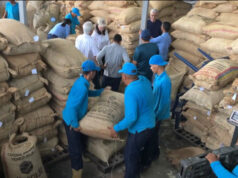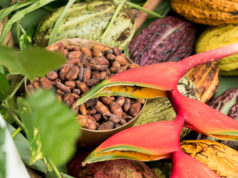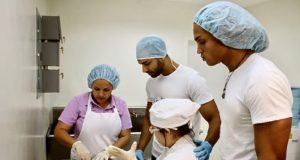By Juan Pablo Crespo
Photos: Courtesy of Elvis Portillo / Liliana Elías
When it comes to knowledge on cocoa, Elvis Portillo is one of those references that should not be missed in any inquiry agenda. He has been occupying the Deanery in the Faculty of Agricultural Science at the University of Zulia (LUZ, in western Venezuela) for three years, with twenty-four continuous years of research and academic teaching. There, sitting at his desk, he holds in his left hand different types of cocoa seeds and, in a kind of “flashback” he says that for him they represent an intertwined combination of life, tradition and culture from which he could never be apart.
The connection between Portillo and the tropical fruit started long before he stepped on the corridors of LUZ for the first time. To understand this unbreakable bond as his passion for teaching, all we have to do is to investigate his origins. Portillo was born in the south of Maracaibo Lake, specifically in Santa Bárbara del Zulia, an area characterized by immense plains of exuberant humid forest. A land so fertile that only stones have held out against developing roots.
The South of lake Maracaibo means haciendas, herds and farms, canyons, rivers, swamps, lagoons and a unique biodiversity. Its forestry, agricultural, livestock and aquatic potential does not seem to touch the ceiling, although historically not made the best of it. Livestock and banana are two of its emblematic areas, as well as the Criollo, Porcelana and Guasare cocoas, of special organoleptic characteristics for making exquisite chocolates, but with a low production.

Under the shade
“The banana was introduced in the South Lake as a shadow for the cocoa. The initial idea was that after offering its shade, the banana was removed so that the cocoa could continue to develop. However, the opposite was done. Hence, now there are 50 thousand hectares of bananas instead of 50 thousands hectares of cocoa in South of lake”
In Santa Bárbara del Zulia Portillo grew up away from the hustle and bustle of the city, eating banana, watching, feeling and tasting cacao seeds. Today he is a professional taster who shares his knowledge both in the classroom and in the laboratory with agricultural engineers on training.
– Since childhood, your life is related to cocoa, what does the seed mean to you?
– For me, cocoa is life, a tradition and culture that we must reinforce generation by generation. It is a crop that we can define as social because it involves both the producer and his family environment, with their rites or customs. Cacao is also one of the best options for the Venezuelan development.
-How much potential do our cocoa beans have?
– Cocoa is one of our products with the greatest competitive advantage, almost like oil. That’s why it is called “brown gold”. If we did things correctly with a long-term vision, we could become a cocoa world power.
After completing his elementary and high school studies in Santa Bárbara del Zulia, Portillo packed his bags and moved to Maracaibo. Amongst his luggage there was no room for doubts, so he went straight to the Faculty of Agricultural Science at LUZ and was matriculated in 1984.
“And after graduating from college, what happened next?”
-A year later I won a competition to become a university teacher and I began to work on the seat of continual crops, such as coffee, cocoa, sugar cane, oil palm, among others, but I fell in with cocoa due to my connection with it since my childhood. In fact, my first research work was on cocoa production in the South of Lake Maracaibo in 1995. The study was published in a scientific journal of LUZ. In 1996 we organised the First Agronomic Conference on Cocoa, in Mérida state.
Portillo tells us that at that time cocoa was seen as a marginal or livelihood crop. Hence, together with the Agricultural Engineer Iraima Chacon (current Coordinator of the Socialist Centre for Research and Development of Cocoa, affiliated to CORPOZULIA) started a great crusade to give a boost to production and to strengthen quality processes.
In 1997 he packed his luggage again and head towards the Central University of Venezuela (UCV, Caracas) to do a postgraduate. That same year, the Cocoa Agenda was founded by the National Fund for Science, Technology and Innovation (FONACIT), in which he participated with a study focused on fermentation processes. Subsequently, he moved to the city of Maracay to do a master’s degree and develop a thesis on post-harvest conditions and the quality of cocoa.
His wanderings in Venezuela took him to meet some French researchers, from the Centre for International Cooperation in Agronomic Research for Development (CIRAD), who were developing different works in the country on the quality of Venezuelan cocoa. “We made contact with these experts because there was a supplement to my thesis on the quality of sensory analysis of cocoa, which was not available in Venezuela at that time. Therefore, we had to send samples to CIRAD (France), where they prepared chocolates and tasted tem according to post-harvest treatment performed here. “
In 2000 the French were interested in developing a research project together with the Venezuelans in the South of Lake Maracaibo, focused on Porcelana cocoa, “one of the most relevant internationally thanks to its genetic and organoleptic features” The dean points out.

Between Venezuela and France
The studies on the grain and its aroma continued together with the French researchers from the CIRAD. Then, the opportunity arose for Portillo to do a Doctorate in Food Science at the University of Montpellier II.
“Did the investigations of the CIRAD experts come until that?”
– No, afterwards they chose three Venezuelan researchers to develop another project on study of the genetic part of cocoa aroma, based on molecular markers.
After several years of experience in teaching and research, Portillo packed his luggage again and took his passport to address to CIRAD, in France. There he spent three months learning laboratory analysis techniques. “Another interest in knowledge was awakened and, in 2002 I started a doctorate in Food Science at the University of Montpellier II, specifically in the study of the cocoa aroma. There have been five years between France and Venezuela, bringing Venezuelan cocoa samples to France and carrying out tests. “
–What other researches could you carry out during your stay in France?
-I did a whole study on aromatic compounds, from volatile and non-volatile compounds to the sensory part of Venezuelan Criollo cocoa with Porcelana background.

The route of chocolate raises the curtain
Back in Venezuela in 2007, Portillo was appointed to the coordination of the Route of Chocolate, created the same year by the national government, with great success while in operation. At the same time, the Agricultural Science Engineer from the South of the Lake continued teaching and publishing research studies, most of them related to handling post-harvest of cocoa.
– How were those first steps of the Route of the Chocolate?
– The Route of Chocolate was nationwide and in the west it began in three municipalities of Zulia state: Rosario de Perija, Francisco Javier Pulgar and Colon. In those days the new Organic Law of Science, Research and Technology was also enacted. This law stipulated that those companies having incomes exceeding 100,000 tax units were required to make social contributions. Based on this framework I made contact with the oil company Shell-Venezuela and submitted the promoting project on the Route of Chocolate in Zulia through training, technical assistance and research.
-The Route of Cocoa was very successful, why?
-Because it allowed to organise producers in small cooperatives or associations in order to find out their needs, projects and lines of investigation in unison with the University of Zulia.
-And what else was achieved with this initiative?
– This project brought added value to cocoa from the creation of small cooperatives in which women and their children participated in making some cocoa by-products. With the contribution of Shell, we went from three to ten producing municipalities. Subsequently, other companies such as the state oil company PDVSA joined. Hence, we managed to train more than 200 producers as well as to increase the production of cocoa and its sowing area. It resulted in a positive socio-economic impact from 2007 to 2012. An information system was also developed to state the producer’s characteristics and geographical location. Additionally, we installed three cocoa nurseries in the municipalities of Sucre, Colón and Rosario de Perijá.
– And what happened next with the Route of Chocolate?
-In 2012 there was change in the Development of Science and Technology Foundation. The projects were reduced and centralised, as well as the resources. As a consequence of this centralisation, the companies stopped making contributions. Before this new reality, the nurseries were practically dismantled.
Reactivation on-hold
Researchers of Venezuelan cocoa are now promoting the reactivation of the Route of Chocolate, but it is necessary that specialised public institutions take the reins.
–We understand that steps have been taken and meetings held for the reactivation of the Route of Chocolate…
– Yes, last July a group of cocoa researchers held a meeting in Maracay (Aragua state) to try to resume this project. We also want to organise in 2017 the III National Cocoa Congress, in a venue yet to be defined. Soon we will have other meetings and details about the event, which I am organising.
–Have government institutions made contact with you for the reactivation of the Route of Chocolate?
– So far, no government agency as the Ministry of Science and Technology has officially established contact with us. The route cannot be reactivated without the participation of specialised public offices responsible for defining the guidelines, logistics and economic resources, which are important. It is necessary to establish where we reached in 2012, what was done and what remains to be done in order to project the work to follow. The integral follow-up is essential, as well as the participation of the Ministry of Agriculture and Lands.
– And what do you look for with the III National Cocoa Congress?
-Firstly, to exchange experiences. Just as in other kind of congresses, such as medicine or engineering, we need to exchange information. The aim is to get together researchers and producers. We want this third cocoa congress to become the first national meeting of cocoa producers in order to exchange experiences and establish lines of work. We all need to be up to date with the advances in post-harvest, nursery, good agricultural practices, genetics, pruning, fertilization, sustainable cultivation and other topics of interest in the cocoa world.
– Why do you consider important the reactivation of the Route of the Chocolate as a long term project?
-Because it would determine a goal to achieve for all sectors involved with the seed. This would mean organising, as I said, producers in cooperatives or associations, technology transfer, training, developing added values and reaching, why not, ecological niches or the appellation of origin. All this has to lead to a combined effort, similar to what it is done in Ecuador, Colombia or Peru, where their production range from 2000 to 3,000 kilograms of cacao per hectare, while we continue talking about 300 to 400 kilos per hectare.

Clones for production
Portillo believes that working with clones that ensure the genetic features of our product is essential to increasing cocoa production. He also emphasizes the need to improving post-harvest processes.
– How do we take that leap?
– With clones” Here in Venezuela we continue to work with sexual or botanical seeds, but we have to work with clones, grafts, twigs to ensure the genetic characteristics of the material we have and to reduce the time of reproduction. There are more than 100 thousand hectares with good potential for this use in South of the Lake, among the states Zulia, Mérida, Táchira and Trujillo. But, we are in need of a long-term plan and some political will. We cannot compete with Africa in quantity, but we can increase the sowing area of cocoa to about 50 thousand hectares and then to 100 thousand or even up to 200 thousand hectares. We can increase sowing area to 10,000 hectares per year within a decade. Of course, we must simultaneously improve our yields and strengthen our post-harvest processes. We hold a tremendous potential because we have the lands, the producers and the trained technicians, as well as the genetic material.
– How can you describe Venezuelan cocoas, especially the Porcelana and Guasare?
-All Venezuelan cocoa beans are very good. Each region has its own particular organoleptic characteristics. Here in the South of the Lake we have the Porcelana and the Guasare. Being Porcelana cocoa the first cocoa with a malted flavour and an excellent caramel to making exquisite chocolates and bonbons. Guasare also has a special fruity flavour. Both have captive international markets and therefore, chocolate makers are eager to have them in their recipes.

After more than an hour of fluent conversation with Vivaelcacao, Elvis Portillo now takes a cocoa bean in his left hand and, in a thoughtfully manner, he insists on the potential of cocoa in Venezuela, even though he emphasizes that it is necessary to an organisation and a long-term vision to allow us to take full advantage of our native cocoa. For this Agricultural Science Engineer from the South of the Lake Maracaibo, who breathes cocoa, the work for the seed and its people will remain an unshakeable and an immeasurable passion.









soy pequeño productor de cacao, me gustaría contactarlos, vivo en Caja Seca, 0414 0656988 opaz53@gmail.com
Por supuesto, escríbanos a vivaelcacao@gmail.com explicando un poco su inquietud y luego le llamaremos.
Saludos
Felicito y admiro a todo aquel que con su esfuerzo, conocimiento, motivacion hacen aun posibles que Venezuela pueda llegar a tener ese respeto de un país altamente productivo y con calidad como fue el cacao, el café y otros cultivos. Los felicito por dedicarles tiempi al cocaína, fruto que tanto quiero. Viene al país y a America un proyecto agropecuario por la FAO, CAF, OCDE, BID y FONTAGRO. Los mantendré informados. Éxito y saludos a Andreina Portillo.
Gracias por leernos sr. Enrique, esperamos contar con usted siempre.
muito bem, adorei o seu trabalho sou filho de Canaveiras berço do cacau comum da Bahia gostaria de conhecer o cacau Venezuelano e sue trabalho de beneficiamento tenho experiencia de campo na cultura do cacau… feliz ano novo , Cherles Matos
Muchas gracias señor Cherles, nos encantaría ayudarle a conocer nuestro cacao y a la vez conocer el suyo. Estamos a la orden para lo que necesite. Saludos y Feliz año!
Comments are closed.